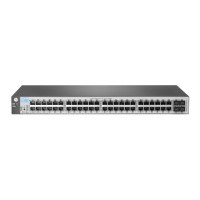
Do you have a question about the HP V1810-48G and is the answer not in the manual?
| Form Factor | Rack-mountable |
|---|---|
| Switching Capacity | 96 Gbps |
| Forwarding Rate | 71.4 Mpps |
| Layer | Layer 2 |
| Power Supply | Internal |
| MAC Address Table Size | 16, 000 entries |
| Operating Temperature | 0°C to 40°C |
| Storage Temperature | -40°C to 70°C |
| Ports | 48 x 10/100/1000 ports |
| Management | Web-based |
| Jumbo Frame Support | Yes |
| Features | VLAN, QoS, IGMP snooping |
| Storage Humidity | 5% to 95% non-condensing |
| Operating Humidity | 10% to 90% non-condensing |
Describes the physical components and design of the HP V1810-48G Switch.
Details the types of network connections supported, including RJ-45 and SFP slots.
Explains the function of each status indicator LED on the switch for system monitoring.
Describes how to use the LED mode select button to change port LED display functions.
Details the function of the reset button for rebooting and self-testing the switch.
Explains the use of the clear button for deleting passwords or restoring factory defaults.
Lists the key capabilities and technologies supported by the HP V1810-48G Switch.
Outlines power-saving features like LED Power-Down and Auto Port Power-Down.
Lists all components shipped with the HP V1810-48G Switch for installation.
Provides a step-by-step guide for the physical installation of the switch.
Highlights essential safety and setup considerations before installing the switch.
Specifies the necessary clearance around the switch for proper ventilation and cabling.
Details the process for mounting the switch securely in a standard 19-inch rack.
Describes the procedure for mounting the switch on a wall surface.
Explains how to place the switch on a table or other flat surface.
Covers the optional use of a security cable to prevent unauthorized removal.
Guides on how to safely install and remove mini-GBIC fiber optic modules.
Steps to access and perform the first-time setup via the web interface.
Instructions for modifying PC network settings to communicate with the switch.
Points to additional resources for advanced configuration and features.
Provides solutions for common problems encountered with the switch.
Explains how to interpret LED patterns for identifying switch faults.
Describes how to use reset functions to test switch circuitry and operation.
Details the procedure to revert the switch to its original factory settings.
Information on how to obtain technical assistance from HP.
Lists essential information to have ready before contacting support.
Details the physical dimensions and weight of the HP V1810-48G Switch.
Lists power requirements, AC voltage range, and frequency.
Outlines operating and non-operating temperature and humidity ranges.
Provides the noise emission levels for the device.
Lists the safety standards the product conforms to, such as EN 60950-1.
Details IEEE standards and laser safety information for supported technologies.
Defines requirements for twisted-pair copper and fiber optic cabling.
Specifies supported distances for different network technologies and cable types.
Explains the use of special patch cords for Gigabit-LX ports to prevent transmission errors.
Describes pin assignments for twisted-pair network cables and Auto-MDIX.
Details wiring and pin assignments for straight-through cables at 10/100 Mbps.
Details wiring and pin assignments for crossover cables at 10/100 Mbps.
Details wiring and pin assignments for straight-through cables at 1000 Mbps.
States compliance with US FCC Part 15 Class A digital device regulations.
States compliance with Canadian EMC Class A requirements.
States compliance with Australia/New Zealand EMC Class A requirements.
States compliance with Japanese VCCI Class A information technology equipment standards.
Provides user guidance regarding Korean EMC Class A regulations for business use.
Warns about potential RF interference in residential environments and user responsibility.
Declaration of compliance with EU directives for Low Voltage, EMC, and CE marking.